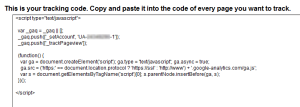
Perhaps not the Data you need, but this picture is probably as useful as the data you currently have.
How effective is your website in getting visitors to do anything?
Does your website ask anyone to do something?
If you want your website to be as influential as it can be, you have only 2 options open to you.
You can use guesswork based on how you feel a site influences people.
Or, you can take a proven, data-driven approach to analysing what’s most effective in influencing your visitors.
First, what exactly do I mean by an effective website?
When you ask someone to do something, does anyone actually do it?
Are you even asking people to do stuff… you might not realise it, but you probably are.
Some examples of things you might be asking your visitors to do include:
- click a link
- download a file
- sign-up to a newsletter
- create an account
- buy your wonderful product
- …
Out of 100 visitors to your site, how many actually click that link you ask them to… 1? 5? 50?
If your site prompts the visitor to do something, wouldn’t you want as many people doing it as possible?
It is after-all why your website is there in the first place – to be influential.
So basically, you want your website to be more influential. To achieve this, it must be more effective at getting people to do stuff you ask them to do.
How can you make your website more influential?
The problem is that you can’t answer this question without a little ground work.
Consider the following 2 links:
[TBS_ROW fluid=”y”][TBS_SPAN size=”3″ offset=”2″]Click Me![/TBS_SPAN][TBS_SPAN size=”3″ offset=”2″]Click Me Now![/TBS_SPAN][/TBS_ROW]
What’s the difference?
On the face of it there’s only 1 word difference here, but ultimately, it could be the difference of 10x more clicks on a link.
Who knows if there’s a different? I know I don’t. Do you?
And that’s the point. No-one knows.
You might feel that adding the word ‘Now’ might get more clicks because of the additional imperative, but how do youknow this to be true if you can’t see it with your own eyes.
In this trivial example, I changed the text by one word, you could also use a button:
[TBS_ROW fluid=”y”][TBS_SPAN size=”3″ offset=”2″][TBS_BUTTON link=”http://google.com” color=”warning” style=”text-decoration:none;” target=”_blank”]Click Me Now![/TBS_BUTTON][/TBS_SPAN][TBS_SPAN size=”3″ offset=”2″]Click Me Now![/TBS_SPAN][/TBS_ROW]
Now which one gets more clicks?
How can you see what people click on?
Okay, so I hope by this stage you’re realising that when you create a website you’re relying solely on guesswork. How your site looks and feels, and the words that you use, are based on how you instinctively feel about how it will influence people.
So how can you “see” what people are doing on your site?
How can you make the right decisions about the most effective way to ask your visitors to take action?
There is only 1 thing you need to help you make these decisions.
DATA.
Now that might have scared a few of you away. But don’t be scared, it’s far easier than you might think.
You basically need to start tracking visitors and their movements across your site.
So, how do you track visitors on your website?
There are quite a few tools out there to help you do just that, but by far and away the most common is from Google, namely Google Analytics.
It works by placing a little bit of tracking code on your site that relays traffic and visitor information back to your Google Analytics account.
Disclaimer: The wealth of information you can immediately begin to see, if you’re not used to it, could blow your mind. I don’t take any responsibility for minds that have been blown.
Information you will typically start seeing within 24hrs include:
- where your visitors are located, even down to the city they’re in.
- how visitors got to your site – did they use a search engine, did another site link to you, or did they type in your address by hand?
- what browser and operating system they’re using.
- what content they are viewing the most – which pages, posts etc.
- … and so much more.
This is achieved simply by placing the necessary tracking code on your site.
There is more you can do even beyond this that I’ll start to get into in later articles.
How to start tracking visitors on your website today
As I’ve mentioned, you need to start tracking your visitors by placing a little snippet of code on your site. Here’s what you do:
- Sign up for a free Google Analytics account (if you have Gmail, you’re halfway there). Do it.
- Within Analytics, click on the ‘Admin’ button at the top then click the ‘New Account’ button.
- Fill in the form, detailing your website information and then click ‘Get Tracking ID’
- The most important piece of information is your Tracking ID. This will be of the form: UA-12345678-1
- You’ll also be presented with something that looks a little like the image below. This is the core of your tracking code. At this stage, how you include this in your website is dependent on your website.
If you have someone managing your site, give them this javascript code and ask them to include it on all your pages.
How to include your Google Analytics tracking code on a WordPress site
If you’re running WordPress, it’s easy – install and activate this Google Analytics plugin on your site.
Using this plugin you can simply specify the tracking code ID you were given (step 4 above), and this plugin will do all the heavy lifting.
This plugin also offers the ability link to your Google Analytics account and get a list of all your tracking IDs. Then, you simply select the one you want.
The next step to tracking your website’s effectiveness
Creating a Google Analytics account and installing tracking on your site is a pre-requisite to anything I can share with you about tracking your site performance and ultimately your influence.
If you need more guides on helping you get the tracking ID on your site, while some of them might be out of date, you could try reading here, here, and here.
In subsequent articles, I’m going to detail a little more about what I’ve been up to in terms of tracking and testing to show you just how incredible the results can be.

{ 3 comments… read them below or add one }
thanks for the link love?
that’s odd… not sure why it did a question mark……!
Really helpful article Paulie. Often when I read articles on this topic, they are complicated with too much jargon or tech language. You explain it well and in bite-sized chunks for non-techies. Look forward to next parts.